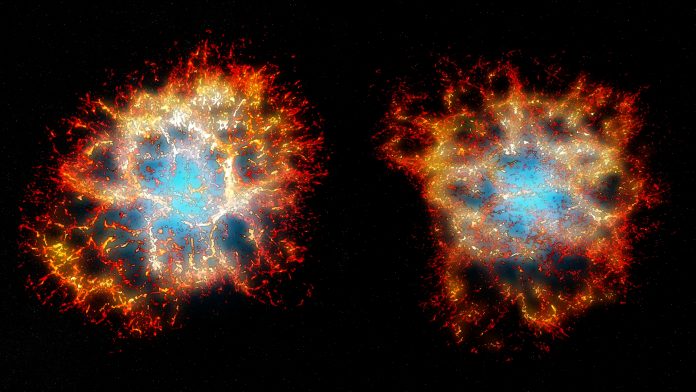Astronomers studying the Crab Nebula have discovered a unique ‘heart-shape’, with wisps of gas filaments showing an intricate honeycomb-like arrangement at the centre of the iconic supernova remnant.
As described in Monthly Notices of the Royal Astronomical Society, the team have mapped the void in unprecedented detail, creating a realistic 3D reconstruction. The Crab Nebula exploded as a dramatic supernova in 1054 CE and was observed over the subsequent years by ancient astronomers across the world. The resulting nebula has been studied by amateur and professional astronomers for centuries. However, despite this rich history of investigation, many questions remain about what type of star was originally there and how the original explosion took place.
Thomas Martin, a researcher at Université Laval who led the study, hopes to answer these questions using a new 3D reconstruction of the nebula. He added: “Astronomers will now be able to move around and inside the Crab Nebula and study its filaments one by one.”
A history of turbulent mixing and radioactive plumes
The team used the powerful SITELLE imaging spectrometer on the Canada-Hawaii-France Telescope (CFHT) in Mauna Kea, Hawaii, to compare the 3D shape of the Crab to two other supernova remnants. Remarkably, they found that all three remnants had ejecta arranged in large-scale rings, suggesting a history of turbulent mixing and radioactive plumes expanding from a collapsed iron core.
Co-author Dan Milisavljevic, an assistant professor at Purdue University and supernova expert, concludes that the fascinating morphology of the Crab seems to go against the most popular explanation of the original explosion. Milisavljevic said: “The Crab is often understood as being the result of an electron-capture supernova triggered by the collapse of an oxygen-neon-magnesium core, but the observed honeycomb structure may not be consistent with this scenario.”
The new reconstruction was made possible by the ground-breaking technology used by SITELLE, which incorporates a Michelson interferometer design that allows scientists to obtain over 300,000 high-resolution spectra of every single point of the nebula.
Supernova explosions are among the most energetic and influential phenomena in the universe. Consequently, Milisavljevic adds: “It is vital that we understand the fundamental processes in supernovae which make life possible. SITELLE will play a new and exciting role in this understanding.”









